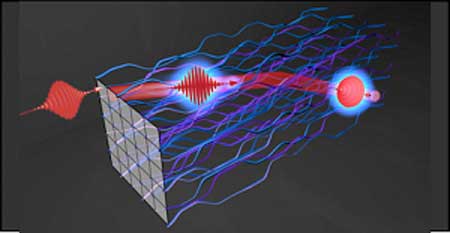| Nov 06, 2020 |
Photons protect their path using topology
(Nanowerk News) An International effort participated by ICFOnians Dr Yaroslav Kartashov and Prof Lluis Torner, and colleagues from the University of Rostock, the University of Lisbon, and the Moscow Institute for Science and Technology, has developed a novel type of nonlinear photonic circuitry in which light beams can define their own path and, in doing so, render themselves notably impervious to external perturbations.
|
|
The demonstration was published in Science ("Nonlinearity-induced photonic topological insulator").
|
 |
| Nonlinearity-induced topological insulator (Image: Lukas Maczewsky, University of Rostock)
|
|
“Photons are an unruly bunch,” explains University of Rostock’s Professor Alexander Szameit, leader of the collaboration and of the group that carried out the experimental demonstration. “As soon as one manages to herd them towards one specific point in space and time, they immediately disperse once again in all directions.”
|
|
Indeed, centuries of research have been devoted to shaping the flow of light by a number of means: Lenses and curved mirrors can tightly focus rays from the sun. Powerful lasers generate coherent beams and short pulses of intense light. And fiber-optic cables deliver staggering amounts of optically encoded data across the world wide web.
|
|
Yet, light waves are surprisingly delicate entities: A small crack in a lens, a mote of dust drifting through a laser beam, or a kink in the fiber can upset the intricate mechanisms that transform photons into one of the most versatile technological tools ever harnessed by humanity.
|
|
Once in a while, nonlinearity helps - as in the optical solitons that have been studied by more than two decades in Prof Torner’s ICFO group - and topology too.
|
|
Electronic topological insulators – solids that do not conduct electricity inside their bulk, yet at the same time are perfectly conductive along their surface – were realized in 2007. While photonic topological insulators can guide light along precisely defined paths, and the mathematical framework underpinning their design endows them with an unprecedented degree of robustness towards imperfections or external perturbations, demonstrating the sought-after properties presented a formidable obstacle.
|
|
The successful collaboration that lead to the milestone reported today in Science overcome the difficulty and demonstrated the concept that paves the way to fascinating and far-reaching applications, in another example that advancing the frontiers of knowledge is best achieved through global international efforts – despite COVID19 et al.
|

